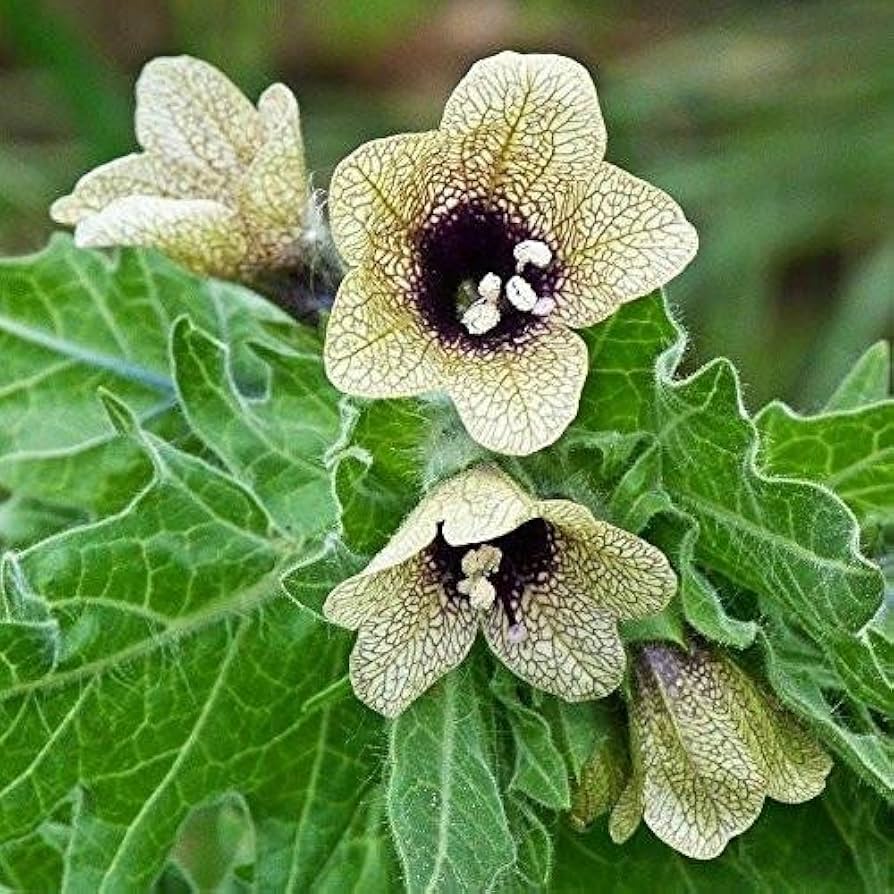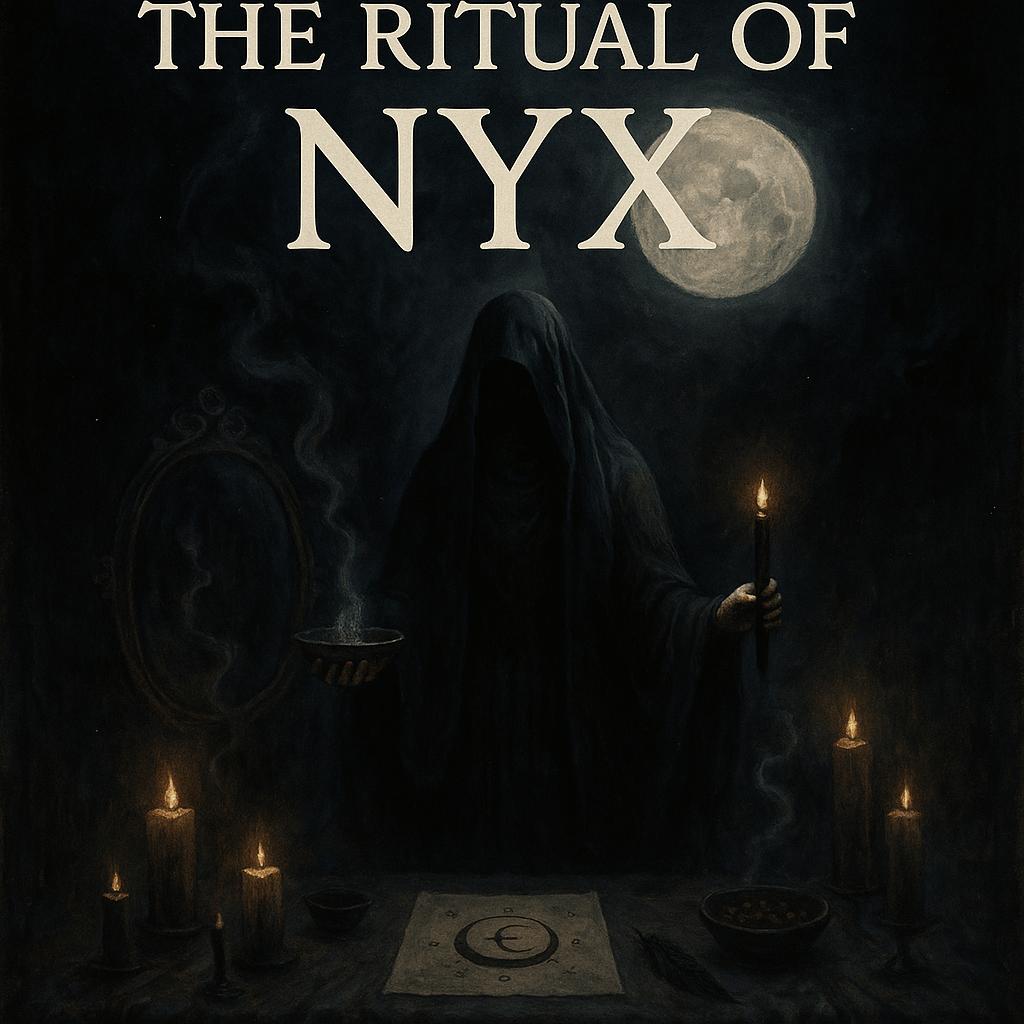Your cart is currently empty!

Henbane: A Fascinating Journey Through Mystery, Medicine, and Magic
Disclaimer: The following article explores the history, folklore, and uses of henbane (Hyoscyamus niger) from an educational and historical perspective. Henbane is highly toxic and can be lethal even in small doses. This article is not intended to encourage the use of henbane in any form. Always consult a medical professional or expert before handling any potentially poisonous plants. The recipes and practices described here are for symbolic or historical interest only.
Introduction: The Allure of Henbane
In the shadowy corners of herbal lore and ancient rituals lies a plant shrouded in mystery and controversy: henbane. With its pale yellow, purple-veined flowers, hairy leaves, and a pungent aroma that whispers danger, henbane (Hyoscyamus niger) is as fascinating as it is deadly. For centuries, this herbaceous biennial has been both revered and feared for its dual role as a powerful healer and a perilous poison.
Henbane’s tale is one of contrasts: a botanical marvel entwined with tales of magic, medicine, and mystery. From ancient temples to witches’ cauldrons, let us delve into the enchanting history and mystical uses of this captivating plant.
The Botanical Marvel of Henbane
Belonging to the notorious nightshade family (Solanaceae), henbane contains potent tropane alkaloids such as hyoscyamine, scopolamine, and atropine. These compounds wield immense power over the nervous system, inducing hallucinations, delirium, and psychoactive experiences even in minute quantities. While this makes henbane a plant of great medicinal and magical significance, it also renders it exceptionally dangerous.
Henbane Through the Ages
Ancient Civilizations
Henbane’s story stretches back thousands of years to ancient cultures that revered its mysterious properties.
- Egyptians used henbane in religious rituals, possibly to induce trances and connect with the divine. Its psychoactive properties were believed to open doors to otherworldly realms.
- Greeks associated henbane with prophecy and divination. The famed Oracle of Delphi, the Pythia, is thought to have inhaled henbane fumes to achieve her prophetic visions.
- Romans employed henbane as an analgesic, often combining it with wine to dull pain or induce a state of euphoria.
Medieval Europe
The Middle Ages brought henbane to the forefront of both medicine and magic. Physicians used it cautiously for pain relief and sedation, but its psychoactive properties also wove it into the fabric of witchcraft and folklore. Hung in homes, henbane was thought to protect against evil spirits, yet its connection to witches and sorcery cemented its dark reputation.
Medicinal Uses of Henbane
Historically, henbane was used to treat a variety of ailments, albeit with great caution:
- Pain Relief: Its alkaloids dulled even the most severe pain.
- Sedation and Insomnia: Henbane’s calming properties eased anxiety and sleeplessness.
- Muscle Spasms: Anticholinergic effects helped alleviate tremors and spasms.
- Anesthetic: Combined with substances like opium, henbane served as an early surgical anesthetic.
Today, modern medicine uses synthetic derivatives of henbane’s compounds. Scopolamine treats motion sickness, while atropine counteracts nerve agent poisoning. However, the raw plant’s toxicity has rendered it obsolete in mainstream medical practice.
The Magical Mystique of Henbane
Henbane’s legacy in magic and folklore is as potent as its alkaloids. Its hallucinogenic properties made it a staple in witches’ flying salves and rituals designed to commune with spirits or access altered states of consciousness.
Witches’ Flying Salves: Fact or Folklore?
Legend has it that witches concocted “flying salves”—ointments infused with henbane and other psychoactive herbs—to achieve sensations of flight and spiritual journeys. Here is a glimpse into the historic and modern adaptations of these recipes.
Historically, the term “flying potion” refers to a salve or ointment rather than a drinkable liquid. These ointments were made by combining psychoactive plants with animal fat or oil, creating a substance that could be applied to the skin. Henbane was a key ingredient due to its hallucinogenic properties, and it was often combined with other toxic plants.
Recipe 1: Flying Potion (Historical)
Ingredients:
- Henbane (Hyoscyamus niger) leaves and seeds
- Belladonna (Atropa belladonna) berries or leaves
- Mandrake (Mandragora officinarum) root
- Datura (Datura stramonium) seeds
- Wolf’s bane (Aconitum napellus) leaves
- Animal fat (e.g., goose fat or pig fat)
Preparation:
- Dry and crush the plant materials into a fine powder. Be extremely careful, as all the ingredients are highly toxic.
- Render the animal fat by melting it over low heat. Strain out any impurities.
- Mix the powdered plant materials into the fat, stirring thoroughly. Heat the mixture gently for several hours to extract the active compounds into the fat.
- Allow the mixture to cool, then strain it through a fine cloth or sieve to remove plant debris.
- Store the resulting ointment in a sealed jar.
Use: Apply a small amount to the skin, particularly to thin-skinned areas like the inner thighs, wrists, or temples. Be warned that even slight misuse could lead to severe poisoning, delirium, or death.
Recipe 2: Simplified Flying Salve
This version uses fewer ingredients and is based on historical accounts but is still dangerous.
Ingredients:
- Henbane (Hyoscyamus niger) leaves
- Belladonna (Atropa belladonna) leaves
- Olive oil or beeswax (as a base)
Preparation:
- Dry and grind the henbane and belladonna leaves into a fine powder.
- Heat olive oil gently and mix in the powdered leaves. Let it infuse for several hours.
- Strain the oil to remove plant material. Add beeswax to solidify the mixture if desired.
- Store in a sealed jar.
Use: As with the previous recipe, apply sparingly to thin-skinned areas. Historically, this salve would induce hallucinations, such as sensations of flying or communing with otherworldly beings.
Recipe 3: “Flight of Dreams” Modern Adaptation (Non-Toxic)
For those interested in the symbolic experience of creating a “flying salve” without the toxic ingredients, here’s a safe modern adaptation using aromatic herbs and essential oils.
Ingredients:
- Lavender (Lavandula angustifolia) for relaxation
- Mugwort (Artemisia vulgaris) for dream enhancement
- Chamomile (Matricaria chamomilla) for calmness
- Essential oils: Sandalwood, frankincense, and clary sage
- Beeswax or shea butter as a base
Preparation:
- Infuse lavender, mugwort, and chamomile in a carrier oil (like olive or almond oil) by heating gently for several hours.
- Strain the oil and melt it with beeswax or shea butter to create a solid salve.
- Add a few drops of the essential oils and mix well.
- Store in a sealed jar.
Use: Apply before sleep or meditation to encourage vivid dreams and relaxation. This salve mimics the ritualistic and sensory aspects of a flying salve without the risks of toxicity.
Ritual Use of Henbane
Henbane was often used in rituals to enter altered states of consciousness, summon spirits, or gain insights into the unknown. Below is a historical ritual involving henbane, along with a safe, modern adaptation.
Historical Ritual: Communing with Spirits
Witches and mystics believed that burning henbane seeds or leaves could summon spirits or create a bridge between the physical and spiritual realms. The smoke was thought to open the mind to visions and revelations.
Steps:
- Gather henbane seeds and dried leaves.
- Burn them in a fireproof bowl or cauldron in a dimly lit space.
- Inhale the smoke lightly to induce a trance state (note: this is extremely dangerous and not recommended due to the plant’s toxicity).
- Use this altered state to meditate or communicate with spirits, often through chanting or visualization.
Modern Adaptation: Henbane-Inspired Ritual for Visionary Insight
For a safer, symbolic recreation of this ritual, substitute henbane with safe herbs that share its mystical connotations, such as mugwort or rosemary.
Steps:
- Prepare the Space: Create a ritual space with candles, incense, and a cauldron or fireproof bowl. Decorate with symbols of transformation, such as feathers (for flight) or mirrors (for visions).
- Select Herbs: Use mugwort, rosemary, or sage for burning. These herbs are safe and associated with spiritual clarity.
- Set an Intention: Write down your intention for the ritual. For example, “I seek clarity and guidance from the spirit realm.”
- Burn the Herbs: Light the herbs in the fireproof bowl, allowing the smoke to fill the space.
- Enter a Trance State: Sit comfortably, close your eyes, and focus on the rising smoke. Breathe deeply and imagine yourself flying or traveling to a distant, mystical place.
- Visualization: Envision yourself crossing a threshold (a door, bridge, or flight) into the spirit world. Visualize meeting a guide or receiving messages.
- Close the Ritual: When ready, open your eyes and ground yourself by touching the earth or drinking water. Thank any spirits or energies you invoked.
This modern adaptation retains the mystical symbolism of henbane rituals while ensuring safety and accessibility.
Interpretation of Effects
The psychoactive effects of henbane, as documented in historical accounts, likely contributed to the sensation of flight, dissociation, and communion with the spirit world. Modern recreations using safe herbs and symbolic practices can replicate the ritualistic and sensory aspects of these experiences without the risk of toxicity.
By combining historical recipes and rituals with modern adaptations, we can appreciate the rich legacy of henbane in magical traditions while respecting its dangers and limitations.
The Dangers of Henbane
Henbane’s toxic nature cannot be overstated. Symptoms of poisoning include dry mouth, dilated pupils, rapid heartbeat, hallucinations, seizures, and even death. Its narrow therapeutic window makes it exceptionally risky to use. Modern handling of henbane is largely confined to controlled research settings.
Toxicology and Risks
Henbane is highly toxic, and its misuse can lead to severe health consequences, including death. Symptoms of henbane poisoning include:
- Dry mouth
- Dilated pupils
- Rapid heartbeat
- Confusion and hallucinations
- Seizures
- Coma
While small doses might have therapeutic or psychoactive effects, the line between a safe dose and a lethal one is perilously thin. For this reason, henbane is rarely used today outside of controlled scientific research.
Cultural Symbolism and Legacy
Henbane’s dark allure has inspired countless legends and literary references:
- A Symbol of Death and the Underworld: Often planted in graveyards and used in rituals honoring the dead.
- A Protective Talisman: Believed to ward off malevolent forces.
- A Poison in Literature: Scholars speculate that Shakespeare’s “hebenon” in Hamlet refers to henbane.
Conclusion
Henbane’s dual nature—as both a healer and a poison, a tool of medicine and magic—renders it one of the most captivating botanicals in human history. Its legacy as a plant of transformation, mystery, and danger continues to spark fascination and inspire imagination. Whether viewed through the lens of ancient rituals or modern curiosity, henbane remains an enduring symbol of humanity’s quest to unlock the secrets of the natural world.






